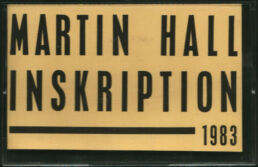INSCRIBE YOURSELF
A consumer’s guide to Inskription (“Inscription”) in relation to the cd-release of the original 1983 performance 20 years later, written by Steffen B. Pedersen
When punk hit the Danish capitol Copenhagen in the late 70’s, it became a catalysing factor in the formation of a much more experimental and fertile musical environment, which reached its artistic peak in the early 80’s. Leaving the original “three chords and the truth”-dictum of the punk scene behind, a vast number of bands, solo artists and musical workshops started exploring a huge variety of musical possibilities to take this influence to a new level of application. And then again: Punk did create a new sense of musical anarchism – but the nihilistic impulse, which tended to follow the angry roar of punk almost everywhere, also trapped many of the Copenhagen bands in a pseudo-goth identity, making most of the releases from this period sound fairly ridiculous today. Very few of the post-punk artists were able to infuse their material with enough originality and honesty to transcend that point in time – notably the darkly psychedelic rock group Sort Sol, the art-rockers Kliché (who came from a similar scene in Aarhus, Jutland) and Martin Hall.
Since then, both Sort Sol and Kliché have been the subjects of pretty thorough re-release strategies. But not Martin Hall. Consequently, most of the many releases, he was involved in between 1978, where he entered the scene as a member of the rudimentary punk band R.A.F., and 1986 – the year he concluded the post-punk phase of his career with the double album Cutting Through – The Final Recordings – have become expensive collector’s rarities today. Why? Well, Martin Hall is the kind of artist, who doesn’t like to dwell too much on his past. The intense sense of presence, which runs through his production, very much applies to his release strategy as well. What’s done is done – what’s next? Which is quite a shame, really: In the early 80’s, his work with groups such as Ballet Mécanique, Under For, SS-Say, Pesteg Dred, Front and Fantasy and Before was definitely strong enough to justify a thorough re-release programme today. The same can be said about his solo output from the same period: The Ritual 12” (1983), the Relief album (1985) and Cutting Through – The Final Recordings. For almost 20 years, the cassette-only release Inskription – a solo concert for violin, voice and tapes, which was performed 5/9 1983 at Radiohuset, Copenhagen, and put out in 1984 as an appendix to the Kong art magazine – also seemed destined to descend into the same well of obscurity. Now, however, this concert has been rescued from the archives to reveal itself as not only a classic in the Martin Hall catalogue, but also a true classic of its period.
In retrospect, Inskription is the culmination of several internal and general tendencies surrounding Hall and his musical production at this point in time. First of all, the work is almost a pure slice of industrial, incorporating and expanding upon the noisy, extreme cut-up aesthetics of British pioneers like Cabaret Voltaire and Throbbing Gristle, who in their turn found their central source of inspiration in the beat novelist William S. Burroughs – the man, who invented the cut-up method with Bryon Gysin. The many “found sounds” and tape loops in Inskription make this connection seem pretty obvious – and like these two bands, Hall used an early kind of sampling technology, which methodically anticipated the house boom of the late 80’s. Unlike the house pioneers in Detroit, New York and London, however, he used this technology to convey a sense of extremity – to create a shock. A feature which referred more closely to the working methods of the early industrial pioneers than their dance-influenced heirs. This is demonstrated by the many playback recordings of sexual activities and screaming animals, which runs through Inskription. But also the accentuations of tribalism, physicality and absolute subjectivity in the parallel manifesto reflects a knowledge of the neo-primitivism of Throbbing Gristle as well as the deeper aspects of the cut-up theory according to Burroughs. To Burroughs, the cut-up method was a tool to break down the systems of significance, which penetrate and define the common human consciousness – the linguistic dualities, that trap the human mind in a constant countdown to a violent extinction – through strategic manipulations. In a sense, Hall cuts up his own reality in the same manner – even if he philosophically seems to be less radical. Instead of destroying the then-current reality completely, he speaks of creating an “existential synthesis of a given industrialism and a latent tribal identity” through his musical collages.
Another evident musical inspiration for Inskription is the American minimalist music of the 60’s, which found a new and enthusiastic audience in the post-punk climate. The many repetitive passages in the work might very well remind the listener of composers like Philip Glass and especially Steve Reich, who consciously used repetition as a tool for reaching a state of primal, almost transcendental being. After studying the trance-inducing methods of the Balinese gamelan-tradition, Reich started defining a new way of composition, which was able to unite the repetitive and generative dimensions of existence effectively. One way of doing this was to make the given musician play to same succession of notes a large number of times, recording each round unto tape and playing the loops simultaneously. Sooner or later the minor failures of each round became so evident during the performance that the theme was altered and expanded through pure imperfection, creating a kind of development through defective monotony. This fundamentalist approach was not entirely reflected in Inskription, but the fine balance between repetition and metamorphosis in this work at least echoed that methodology.
Finally, Inskription was a truly successful example of a central theme in the work of Martin Hall, which continues to permeate his recordings to this day. Even at an early stage in his career – as a member of Ballet Mécanique – he started combining the dynamics of rock with the vast sonic spaces of the classical tradition. The two essential albums by this highly experimental trio – The Icecold Waters of the Egocentric Calculation (1981) and For (1982) – as well as a succession of privately released solo cassettes were more or less different explorations of this basic aim, often incorporating the same cut-up strategies and repetitive elements that are so important to Inskription. Many of these early experiments leaned more to the rock side than the classical side, however, and Inskription was the first true synthesis between the two traditions, establishing a musical space which is violently dynamic and incredibly vast at the same time. The only real parallel in his early catalogue is the Ritual 12” – and even there the two impulses were less integrated for artistic and philosophical reasons. In the last few years, however, a similar and less tormented synthesis of the two musical principles has resulted in equally essential works like Metropolitan Suite (2001) and Camille (2002).
achieve with Inskription? Well, despite the academic rhetoric of the manifesto, the answer to this question is pretty simple after all: Everything and nothing at the same time. Through his performance – which, symbolically, is documented in real time without overdubs – he defines a stretched moment in the reality of the early 80’s. A musical moment, which – according to a number of strict methodological rules – encapsulates the essence of the there and now and makes it refer to more eternal principles. The basic structure of Inskription – which is repetitive and dynamic at the same time – reflects the basic modus operandi of existence itself. By incorporating both trance- and shock-inducing elements, he also forces the listener into an intensive state of physical and mental presence. Finally, the composition – through its use of noise, fractured structures and a consciously deformed tonality – reflects the undercurrents of pain and frustration, which permeate both the industrial society and the musician himself. That’s as close as you’re likely to get to the intention of the work … but it’s more than close enough. The actual interpretation – and that’s one of the best things about Inskription – is wisely left to the mental and physical subjectivity of the listener. Are you feeling pain or elevation, when you’re listening to the work? That’s your interpretation. Do you hear an aural reflection of heaven or hell? That’s more or less your interpretation again – even if most people might agree that the composition is more infernal than celestial. But as long as you’re present – and as long as both your body and your mind is involved in the listening experience – Inskription has worked its own particular magic: To inscribe both your name and the name of the composer into the moment as well as eternity itself.
When the work was originally performed, most listeners thought the composition reflected the nihilism of the post-punk scene. Looking back, however, Inskription was rather an attempt to exorcise the self-destructive mood of the moment than to emphasize it. In other words, Inskription was an attempt to replace the sicknesses of the modern mind with a primal, healthy human self. In that respect, the less you say about the sociological, philosophical and biographic circumstances surrounding the work, the better. The composition should be experienced as it is – and as you are. Actually the only reasonable way to end this introduction is to cut the academical crap and start to listen. The only thing I’ve left to write is my own inscription:
Steffen B. Pedersen, Geiger


